
* Only a few tens of millions of years ago, another catastrophe displaced the dinosaurs, leading to the modern dominance of birds and mammals as large species. One family of mammals, the hominids, that emerged recently is of particular interest to us, since we are among its members.
* Whatever wiped out the dinosaurs and the other great reptiles, the Cenozoic era, beginning 65 million years ago, brought birds and mammals to the fore. There is some discussion over how rapid this transition was, with some claiming the newcomers were getting established well before the end of the Cretaceous. No matter how the transition took place, there was a transition, with all the major mammal orders generally represented by about 50 million years ago.
In modern times, the marsupials are not found in Eurasia or Africa, and are only represented by a relative handful of in the New World -- though the North American opossum, the sole marsupial found in the USA, is a surprisingly successful and widespread creature, thanks to its sturdiness, omnivorous diet, and ability to breed rapidly. However, there was once a much wider range of marsupial species in South America, and diverse marsupial species are still found in Australia, including:
Incidentally, the little "sugar gliders" are fairly common pets in Australia, not merely because they are adorably cute, but because they are easy to keep, lively, curious, and affectionate with their owners.
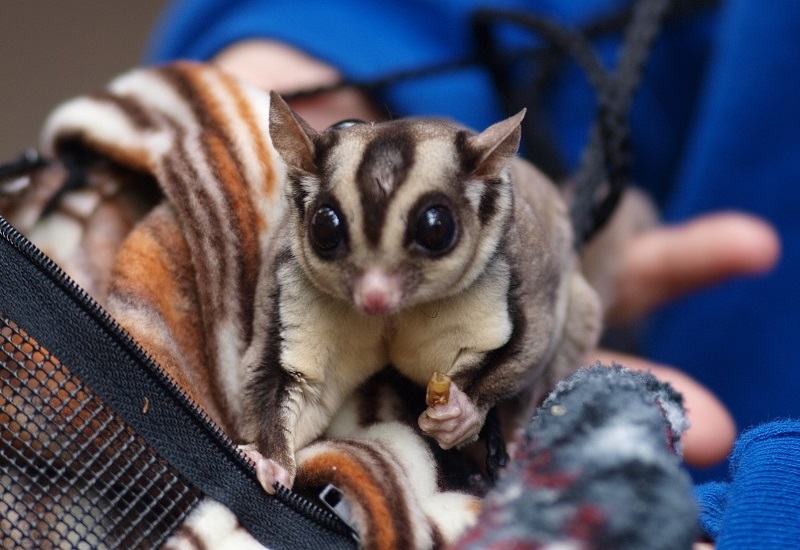
The evolutionary relationships of the marsupials were poorly understood until recent times, but have now been clarified through genomic analysis. The American marsupials include three clades:
The Australian marsupials branched off from the American marsupials to diversify into four groups:
The American opossum is seen as "primitive" marsupial -- again, not in the sense that it is "crude" in some sense, though it looks it, but in that it traces its lineage directly back to and resembles early marsupial forms. It's not surprising the American marsupials represent the older branch, since South America and Australia separated a long time ago, and since then the two components of the marsupials have evolved in parallel.

In contrast to the marsupials, the placentals have a global distribution, and in fact they have had a tendency to push marsupials to the side when they come into competition. The encroachment of placentals into South American when the Panama land bridge was established from the seas seems to have resulted in the widespread extinction of marsupial species in South America.
BACK_TO_TOP* The major groups of placental mammals include:
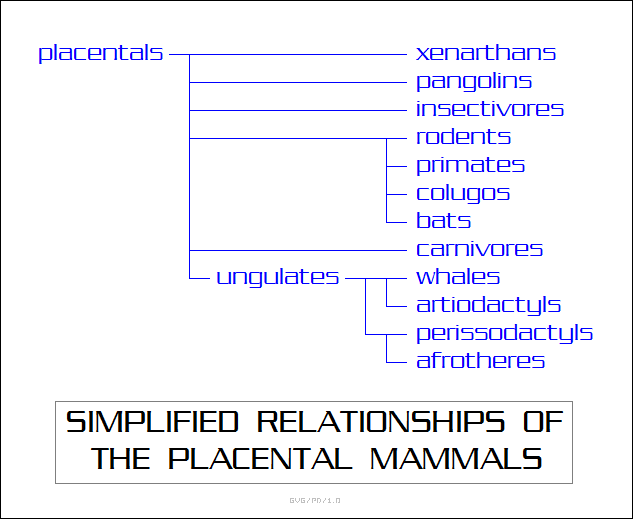
* Early carnivores tended towards the weasel-like in appearance, eventually emerging in modern times in two major groups: the "feliforms", or catlike carnivores, and the "caniforms", or doglike carnivores.
The feliforms now include civets, mongoose, hyenas, and the true cats -- the cats being spectacularly represented by various lineages of "sabretooths", with their huge incisors. There was also a set of feliforms, the "nimravids" or "false cats", that closely resembled "true cats" and even produced sabretooths, but they were a separate lineage, now extinct.
The caniforms are subdivided further into two groups, one being the canids -- including foxes, wolves, and the domesticated variants of wolves we know as dogs -- and the other subdivided into the bears; the "procyonids", including the raccoon and the coatimundi; and the "mustelines", including weasels, badgers, skunks, and otters. Procyonids were once thought most closely related to bears, but today they are known to be closer to mustelines.
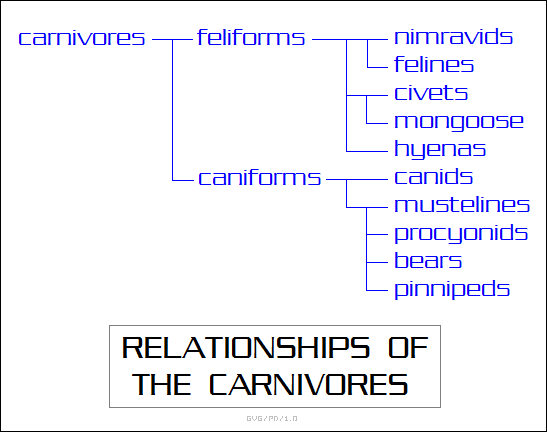
The seals or "pinnipeds" were once classed as a separate order, but if they were excluded, the carnivores wouldn't be a true clade, and so they are now regarded as part of the family. It seems from genetic evidence that they are most closely related to bears. There are three branches of pinnipeds, including the "true seals", the "sea lions", and the "walruses" -- one identifiable difference between true seals and sea lions being that true seals don't have external ears, while sea lions do. Incidentally, the name "carnivore" is a bit misleading, since of course there are plenty of non-mammalian carnivores, and not all of the order of carnivores are meat-eaters -- bamboo-eating panda bears and red pandas, for example.
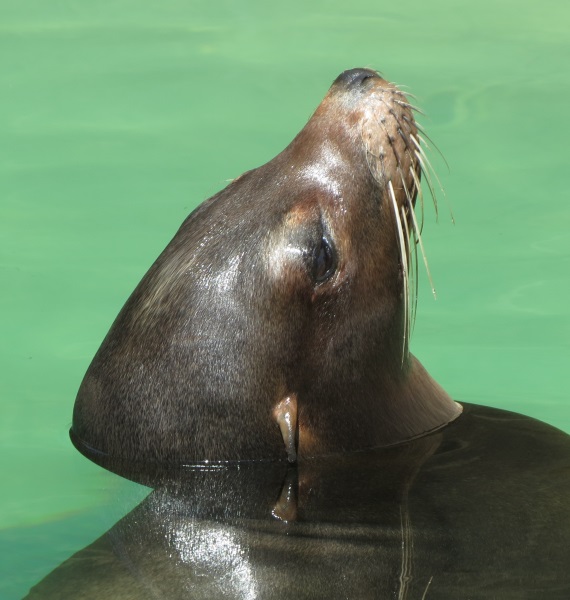
The extinct creodonts, as mentioned, were traditionally lumped with the rest of the carnivores, but in modern reassessments taxonomists have had to admit that they have no real clue where the creodonts belong in the mammalian family tree, and their resemblances to the carnivore family may simply be convergent evolution along a widely separated branch.
It is known that the creodonts were actually dominant over the carnivores early on. It has also been the custom to divide the creodonts into two groups, with the "oxyaenids" ranging from civetlike forms to bearlike forms, such as the Sarkastodon; and the "hyaenodonts" ranging in forms from foxlike to wolflike. However, nobody's that certain of the relationships among the creodonts either, and though these two groups are still retained in use, they may be simply handy paraphyletic associations.
BACK_TO_TOP* A century ago the "ungulates", the hoofed animals, were seen as a single if diverse group, including:
In modern times, it has become obvious that these three groups are more distantly separated than once believed, and that there were some surprising relationships among them to other groups. There was also an entirely separate, extinct branch of related species collected under the name of "condylarths", many of which actually looked like small predators.
To clutter up the ungulate family tree even more, there were the extinct cloven-hoofed "notoungulates" and odd-toed "litopterms" of South America that were not closely related to existing orders of ungulates, nor to each other. They caused no end of confusion for early paleontologists, since there was a tendency to force them into the existing two groups of ungulates, despite the fact that they didn't fit all that well.
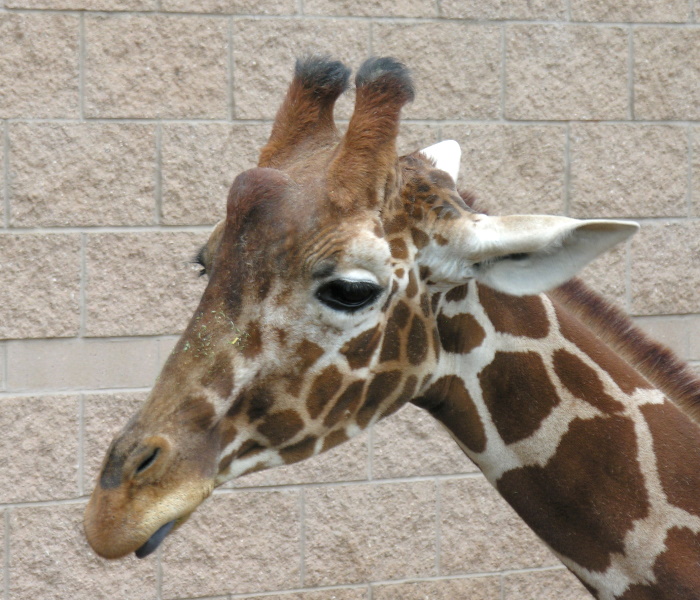
The oldest ungulate fossils are about 55 million years old, though they had more than two hooves -- the evolution of horses from small and five-toed to large and one-toed was discussed earlier. There were interesting extinct side lines among the ungulates, including rhinos bigger than elephants such as Indricotherium, and a giraffe-like camel -- the Aepycamelus, once known as Alticamelus.
* Believe it or not, whales and dolphins, which were once thought to be derived from the carnivore family, have been seen through their genetic patterns to be, surprisingly, an offshoot of the ungulates. Their closest living relative, as mentioned earlier, is the hippopotamus -- and in fact a hippo is more closely related to a whale than a hippo is to a cow. For this reason, in modern times the order "cetacea" has been reduced to a family, and the whales have been absorbed into the artiodactyls to form the "cetartiodactyls". It's an awkward thought, but from a taxonomic point of view the alternative is even more awkward. Of course the whales are very distinct from their land-based relatives, and so even though they have been demoted to a family, they are generally described in the literature a distinctive group. Ironically, a baby whale has long been referred to as a "calf", which turned out to be more right than anyone knew.
The cetacean family tree is both detailed and well established in the fossil record from relatively recent finds, with precursor species featuring four fins -- in fact, in modern times, rare throwback dolphins with four fins have been occasionally caught, with one captured alive in 2006. Even earlier species, discovered in the 1990s and including a complete fossil, had feet and could clearly get around on land. Some early whales were clearly waders; but the lineage that went to the open sea was the one that became established. One of the better known fossil whales, the "basilosaurus" -- incorrectly named to suggest a reptilian -- had an elongated "sea serpent" configuration. It also had its nostrils forward of its eyes, not behind them as in the modern "blowhole" of whales; the fossil record of whales shows how the nostrils gradually migrated from the snout on back.
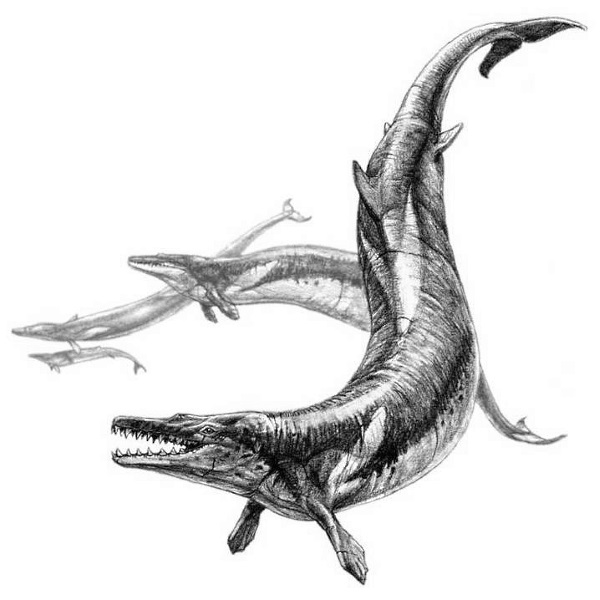
The discovery that whales were so closely related to ungulates was a big shock. That led to some worries about the fact that there are two general classes of whales: the big "baleen" whales, which gulp in big mouthfuls of small food, generally the little shrimplike "krill"; and the toothed whales, like dolphins and killer whales. What if the two subfamilies of whales were unrelated as well? Genetic analysis showed they were actually related, and biologists breathed a sigh of relief.
The fossil record for the emergence of baleen whales from toothed whales is very fuzzy, though a recent discovery named Janjucetus hunderi, dating back about 25 million years, appears to be an "intermediate form" to help plug the gap. Janjucetus was about the size of a dolphin but it had an undolphin-like jaw, very wide, with the suggesting that the whale ate by "hoovering", sucking in water and fish, then chomping down on them. It is possible that Janjucetus represents a dead-end branch and that baleen whales actually evolved by some other path, but the example it presents is suggestive.
Incidentally, in 1866 Ernst Haeckel published his own read on the tree of life, and astoundingly he not only placed cetaceans as a branch of the artiodactyls, he also placed hippos as more closely related to whales. However, Haeckel's correct placement of the whales in his tree of life was not much more than an educated lucky guess, since he classified the manatees as a branch off the whale family tree, when they are much more closely related to elephants.
There was an extinct branch of predatory ungulates, the "mesonychids", in parallel with the cetaceans. They stereotypically looked like a nasty cross between a wild boar and a wolf. The distant ancestors of modern cetaceans were along similar lines.
* As far as the afrotheres go, lumping them in with the artiodactyls and perissodactyls is a bit controversial. It might seem obvious that the elephant is a relative of the rhino, and on the basis of morphology, those two lineages were traditionally associated. Modern genetic evidence, however, suggests the only association between them goes back to the very early days of mammal evolution -- that is, neither is much more closely related to the other than either is to, say, monkeys.
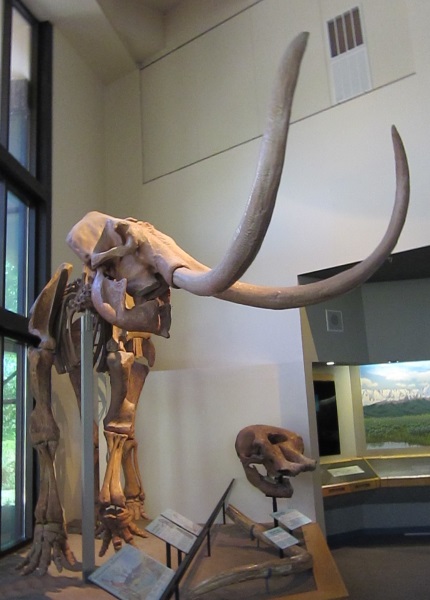
The idea that elephants are related to manatees and hyraxes is not controversial, but the afrotheres have become associated with a fair number of creatures that have proven difficult to place. The African "elephant shrews" or "sengi" -- and their relatives, the spiny "tenrecs" and the "golden moles" of Africa, similar to but distinct from hedgehogs and true moles respectively -- have been thought of as afrotheres, but they have been shuffled around a good deal by taxonomists. The ant-eating aardvark of southern Africa has also been shuffled around, though it is generally believed to be an offshoot of the artiodactyls.
The exact placement of the afrotheres relative to the ungulates, and the exact membership of the group, should be clarified in a few decades. Right now, the genetic and biochemical evidence for the group is a bit sketchy, with relationships being determined primarily by analysis of mitochrondrial DNA -- which critics suggest works fairly well for organisms featuring close relationships with each other, but less well as relationships become more distant as the relationships fade into mutational noise. In fact, there is considerable dispute over the arrangement of the deep base branches of the placental family tree -- but there is little doubt that analyzing the full genome of any organisms will become a cheap and trivial process, and the use of cloud computing power running comparison programs should clarify the relationships once and for all.
It should be noted that, though there have been protests over the idea that the cetaceans are part of the artiodactyls, taxonomists are in general agreement that the evidence shows it's so. Why there should be complaints over the matter is a bit hard to understand. Obviously, whales are descendants of ground-living mammals; why one group of ground-living mammals should be regarded as more implausible as relatives than another seems like a whimsical objection.
BACK_TO_TOP* The "xenarthans" are represented in modern times by sloths, anteaters, and armadillos. In the not too distant past, there were giant ground sloths, as big as elephants, and the giant armadillos or "glyptodonts". The pangolins, scaly anteaters, of the Old World are different beasts, the sole members of the order "pholidota"; and as mentioned the aardvark, though its actual family associations remain unclear, is certainly not a close relative of the true anteaters. All these creatures were once lumped together as "edentates", until it was realized that their external forms were misleading, and they didn't form a close-knit family.
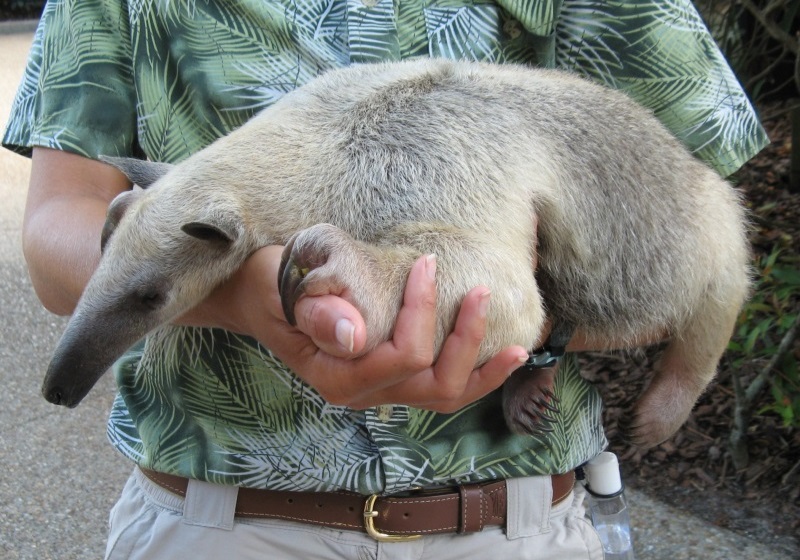
* The "rodents" include mice, rats, squirrels, chipmunks, beavers, muskrats, gophers, and the like. They have proven a very successful order of mammals, having a strong presence over the globe. The rodents are an extremely diverse group of small creatures, with interesting adaptations -- burrowing forms like gophers and mole rats, gliding forms like flying squirrels, beavers with their fascinating instinctive construction of dam systems, and even two groups of porcupines with their nasty quills. The biggest rodent these days is the South American capybara, which is about as big as a mid-sized pig, but it had close extinct relatives the size of a cow.
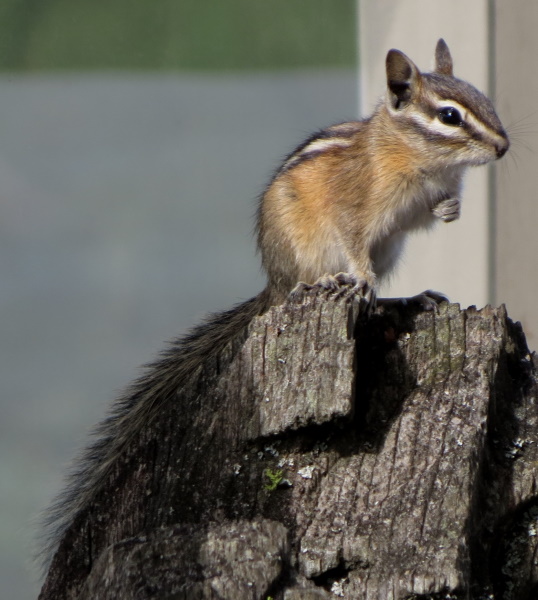
The rabbits and hares are a separate but have been traditionally regarded as a closely related order, though that is contested. Incidentally, there was a discussion in the 1990s over whether guinea pigs were actually rodents or needed their own grouping, but that turned out to be a good example of the confusions that can arise from the use of molecular taxonomy on the basis of too small a sample size, and the consensus these days is that they are indeed rodents. The quarrel over the lineage of the guinea pig of course got intense, with one of warring factionalists admitting: "We people who do taxonomy have a 300-year history of being nasty to each other. I like to keep up with tradition."
* The classic order of "insectivores" includes the shrews, moles, and hedgehogs. The name "insectivore", or "insect eater", is misleading, since not all of them eat insects, and many other sorts of animals are insect-eaters. It turns out that shrews, moles, and hedgehogs, while related among themselves, are only loosely so, leading to an argument over their classification. Also as mentioned above, there is a set of insectivore-like beasts found in Africa, including the sengi, the golden moles, and the tenrecs, that are currently lumped as afrotheres; that placement is a bit uncertain, but nobody thinks they are closely related to the insectivores.
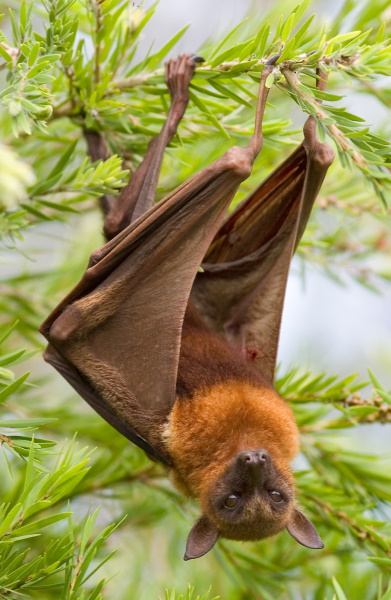
* The bats or "chiroptera" used to be regarded as a flying offshoot of the insectivores, but now that is argued. There are two general groups of bats -- small bats, mostly insect-eaters but with some specializations such as pollinators and (infamously) vampires among them; and the big "flying foxes" or "fruit bats". Some place the two groups of bats as separate orders, and the roots of their actual origins are controversial, since fossils of bats are rare. There are also the "colugos" of Southeast Asia, which resemble large flying squirrels but have a reproductive system that resemble that of marsupials. They have been placed as relatives of bats, though their actual relationships remain, at least for the time being, controversial.
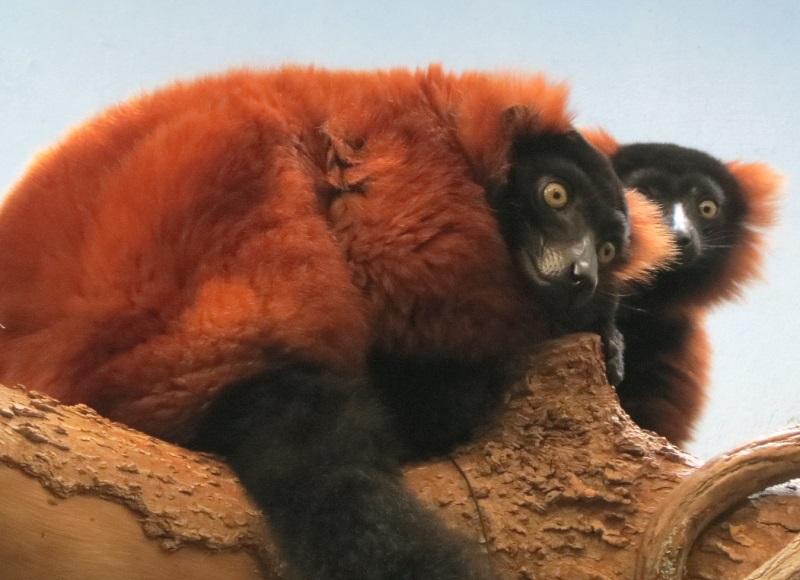
* The last order of mammals, the primates, includes the lemurs and lorises AKA "lemuroids"; the big-eyed tarsiers; the Old World and New World monkeys; and the apes. The lemurs are mostly associated with the island of Madagascar; there were bear-sized forms of them at one time, but they're extinct now. The tarsiers tend to be lumped with the lemuroids as "prosimians", but some believe that tarsiers are more closely related to monkeys. While the Old World and New World monkeys obviously share common roots, they are clearly distinct and easily distinguished, with each group having its unique members -- the Old World monkeys including the intimidating ground-living baboons, the New World monkeys including the squirrel-like marmosets.
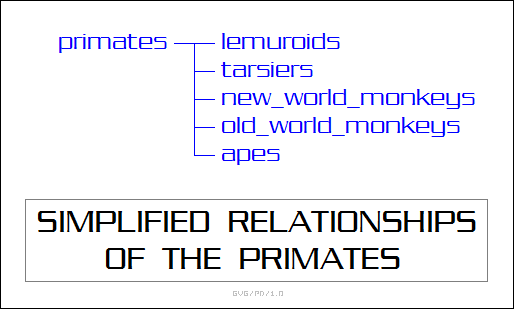
Some have lumped the insectivore-like "tree shrews" into the primates, but few are now comfortable with that notion. Not being all that much like true shrews either, they have generally been stuck in their own order until we can learn different.
BACK_TO_TOP* The apes are collectively known as "hominoids". They are split roughly into the "hylobates", meaning the gibbon and its variants, sometimes called the "lesser apes"; and the "hominids" or "great apes", meaning the orangutan, gorilla, chimp, and the humans. Humans and their extinct relatives, the apes that walk upright, are the "hominins" -- the nomenclature is confusing, particularly because it's changed quite a bit over the past decades, the human branch once having been called the hominids, not hominins. Humans were once regarded as a separate family from the great apes, but modern genetic analysis showed that chimps and humans are more closely related than chimps and gorillas, making the distinction of humans into a separate family unsupportable.
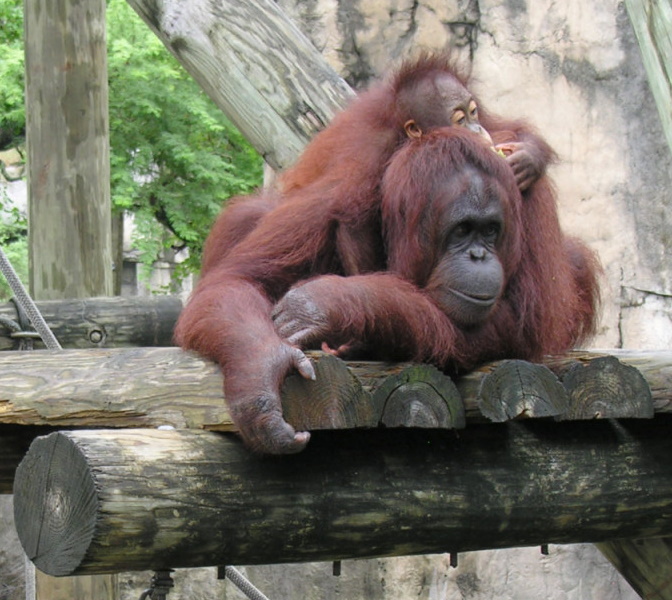
There has been some argument over exactly how close humans are to chimps, with estimates of the similarity ranging from about 94% to over 99%. The precise ratio depends on assumptions used in the measurement; the matter is somewhat academic, since nobody sensibly denies that the genetic resemblance between humans and chimps is much closer than the genetic resemblance between humans and any other species; closer than the genetic difference between chimps and gorillas; well closer than the difference between chimps and orangutans; far closer than the difference between chimps and monkeys. It was the realization of this genetic similarity that led to the confusing reshuffling of the nomenclature of the apes.
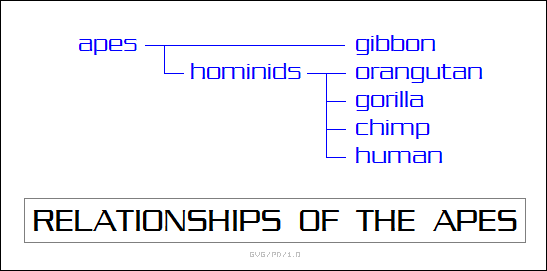
It is generally thought that humans and chimps are so similar that they could interbreed, though probably not produce fertile offspring. Not at all incidentally, any source that mentions this possibility immediately denounces the idea is entirely monstrous and unthinkable -- but in 1927, a Soviet biologist named Ilya Ivanov (1870:1932) who obviously had a few screws loose, actually tried to artificially inseminate three female chimpanzees with human sperm. He even had backing of Soviet scientific authorities in the exercise, but fortunately nothing happened. His efforts to continue his research along such lines went nowhere before his death, and his only legacy was to provide more evidence of the moral bankruptcy of the Stalinist state.
Anyway, the earliest of the upright apes led to the "australopithecines". The australopithecines were followed by a succession of hominin species; given the lack of genetic information, not surprisingly there is considerable argument over the relationships between these species. There is no doubt they have a family relationship, with species that can be seen as "intermediate forms" between the austalopithecines and modern humans, but there is the heavily-argued question of what the precise relationships are.
There is little doubt that the australopithecines led to a side branch in the form of a giant race known as "paranthropus" or "Australopithecus robustus", and they seemed to have used crude stone tools. The paranthropoids were clearly a dead end, but another branch from the australopithecines led to a more humanlike creature, Homo habilus, sometimes called "early Homo", and then to Homo ergaster, followed by the similar Homo erectus -- though some reverse the order between H. ergaster and H. erectus, and some believe that H. habilus was actually a dead-end branch of the australopithecines, not on the path to H. erectus at all.
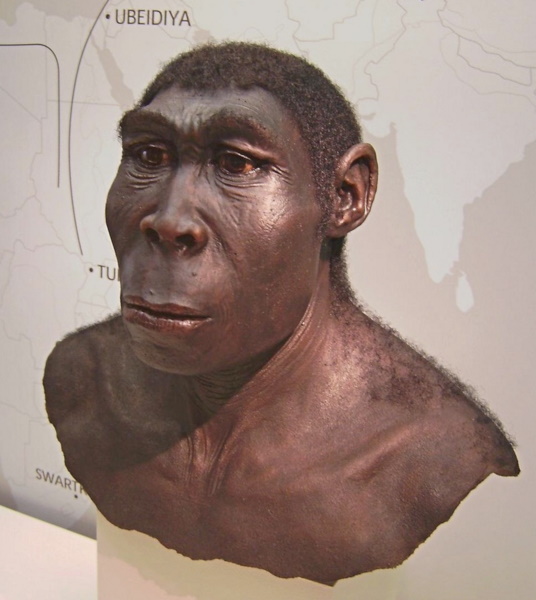
By the beginning of the Quaternary period, a "mere" 1.5 million years ago, the climate was beginning to shift rapidly through a set of ice ages, which were accompanied by the rise of modern human forms. Another branch off the Homo habilus line led to Homo heidelbergensis, a more recognizably human form, with a brain only somewhat smaller than our own. Homo heidelbergensis led in turn to the Neanderthals, beetle-browed but close enough to modern humans to pass for them, and clearly users of tools and fires; and the modern Homo sapiens, an evolutionary development only a few hundred thousand years old.
About 40,000 years ago, Homo sapiens abruptly left the era of stone tools and began to produce pottery, artworks, paintings, and ever more sophisticated tools, an event some have called the "Great Leap Forward", which has continued to production of symphonies, movies, jumbo jetliners, and Mars rovers.
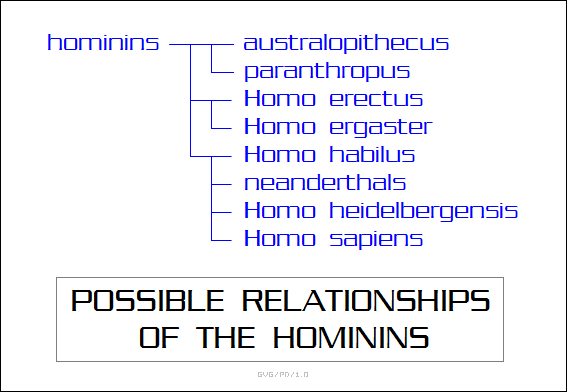
* One of the puzzles in human evolution is the question of why the hominins ended up walking upright. What selection forces pushed the hominins down this branch? Some have suggested it was driven by increased intelligence. That doesn't fly, since the earliest known hominins were fully upright, but didn't have brains any bigger than those of a chimp -- another example of mosaic evolution, with the upright stance not being closely related to brain growth.
Others have suggested that use of tools drove the process, with those individuals that could walk more upright being better tool-users, but in fact the early erect hominids weren't much bigger on using tools than chimps. One plausible idea is that upright hominids were better able to carry food around and stash it; one imaginative idea is that our ancestors liked to forage in the water, where standing upright is obviously more workable than going on all fours.
Some suggest that the hominins picked it up before they ever adapted to life on the ground, since some species of apes, such as gibbons, seem to like to get around on two feet in the trees. Richard Dawkins has suggested that one ape in a group of apes simply learned there were advantages to walking upright, such as being able to pick fruit and carry it around, and made more of a habit of it than the others. The advantages became obvious to the others, so they imitated him -- modern chimps are clever creatures, perfectly capable of learning by example, and these early hominins could be expected to be about as bright -- and this tribe of apes then set off on down the selection treadmill, becoming more and more upright over the generations.
Dawkins pointed out that some chimps in captivity seem to like walking upright more than others, though it doesn't really buy them much in that environment, since they get fed by their keepers the same as others. It should be noted that the pretty little gerenuk antelopes, though clearly four-footed, like to stand on their hind legs to browse on trees and seem to balance themselves fairly well -- would it be too much of a stretch to think of them as possible precursors to "upright antelopes" of the future?
BACK_TO_TOP